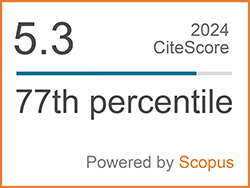A 1-D Convolutional Neural Network with Gradient Mapped Intensity Features for Detection of Mitosis in Histopathological Images
Abstract
Keywords
[1] C. W. Elston and I. O. Ellis, “Pathological prognostic factors in breast cancer. I. The value of histological grade in breast cancer: Experience from a large study with long-term follow-up,” Histopathology, vol. 19, no. 5, pp. 403–410, 1991.
[2] C. Li, X. Wang, W. Liu, and L. J. Latecki, “DeepMitosis: Mitosis detection via deep detection, verification and segmentation networks,” Medical Image Analysis, vol. 45, pp. 121–133, Apr. 2018.
[3] H. Chen, Q. Dou, X. Wang, J. Qin, and P. A. Heng, “Mitosis detection in breast cancer histology images via deep cascaded networks,” in Proceedings of the AAAI Conference on Artificial Intelligence, 2016, pp. 1160–1166.
[4] D. C. Cireșan, A. Giusti, L. M. Gambardella, and J. Schmidhuber, “Mitosis detection in breast cancer histology images with deep neural networks,” in International Conference on Medical Image Computing and Computer-Assisted Intervention, 2013, pp. 411–418.
[5] H. Lei, S. Liu, A. Elazab, X. Gong, and B. Lei, “Attention-guided multi-branch convolutional neural network for mitosis detection from histopathological images,” IEEE Journal of Biomedical and Health Informatics (JBHI), vol. 25, no. 2, pp. 358–370, 2020.
[6] Y. Li, Y. Xue, L. Li, X. Zhang, and X. Qian, “Domain adaptive box-supervised instance segmentation network for mitosis detection,” IEEE Transactions on Medical Imaging, 2022.
[7] N. Inoue, R. Furuta, T. Yamasaki, and K. Aizawa, “Cross-domain weakly-supervised object detection through progressive domain adaptation,” in the IEEE/CVF Conference on Computer Vision and Pattern Recognition, Jun. 2018, pp. 5001–5009.
[8] Y. Chen, W. Li, C. Sakaridis, D. Dai, and L. Van Gool, “Domain adaptive faster R-CNN for object detection in the wild,” in Proc. IEEE/CVF Conf. Comput. Vis. Pattern Recognit., Jun. 2018, pp. 3339–3348.
[9] M. Suchetha, N. S. Ganesh, R. Raman, and D. E. Dhas, “Region of interest-based predictive algorithm for subretinal hemorrhage detection using faster R-CNN,” Soft Computing, vol. 25, no. 24, pp. 15255–15268, 2021.
[10] Y. Xue, G. Bigras, J. Hugh, and N. Ray, “Training convolutional neural networks and compressed sensing end-to-end for microscopy cell detection,” IEEE Transactions on Medical Imaging, vol. 38, no. 11, pp. 2632–2641, Nov. 2019.
[11] X. Zhao, S. Liang, and Y. Wei, “Pseudo mask augmented object detection,” in the IEEE/CVF Conference on Computer Vision and Pattern Recognition, Jun. 2018, pp. 4061–4070.
[12] D. Tellez, M. Balkenhol, I. Otte-Höller, R. van de Loo, R. Vogels, and P. Bult, “Whole-slide mitosis detection in H&E breast histology using PHH3 as a reference to train distilled stain-invariant convolutional networks,” IEEE Transactions on Medical Imaging, vol. 37, no. 9, pp. 2126–2136, Sep. 2018.
[13] Y. Zhang, H. Chen, Y. Wei, P. Zhao, J. Cao, X. Fan, X. Lou, H. Liu, J. Hou, X. Han, J. Yao, Q. Wu, M. Tan, and J. Huang, “From whole slide imaging to microscopy: Deep microscopy adaptation network for histopathology cancer image classification,” in International Conference on Medical Image Computing and Computer-Assisted Intervention, 2019, pp. 360–368.
[14] C. Huang and H. Lee, “Automated mitosis detection based on exclusive independent component analysis,” in Proceedings of the 21st International Conference on Pattern Recognition (ICPR2012), 2012, pp. 1856–1859.
[15] A. M. Khan, H. El-Daly, and N. M. Rajpoot, “A gamma-gaussian mixture model for detection of mitotic cells in breast cancer histopathology images,” in Proceedings of the 21st International Conference on Pattern Recognition (ICPR2012), 2012, pp. 149–152.
[16] D. C. Cireșan, A. Giusti, L. M. Gambardella, and J. Schmidhuber, “Mitosis detection in breast cancer histology images with deep neural networks,” in International Conference on Medical Image Computing and Computer-Assisted Intervention, 2013, pp. 411–418.
[17] H. Chen, Q. Dou, X. Wang, J. Qin, and P. A. Heng, “Mitosis detection in breast cancer histology images via deep cascaded networks,” in Proceedings of the Thirtieth AAAI Conference on Artificial Intelligence, 2016, pp. 1160–1166.
[18] H. Wang, A. Cruz-Roa, A. Basavanhally, H. Gilmore, N. Shih, M. Feldman, J. Tomaszewski, F. Gonzalez, A. Madabhushi, “Mitosis detection in breast cancer pathology images by combining handcrafted and convolutional neural network features,” Journal of Medical Imaging, vol. 1, 2014, Art. no. 034003.
[19] S. Ren, K. He, R. Girshick, and J. Sun, “Faster R-CNN: Towards real-time object detection with region proposal networks,” in Advances in Neural Information Processing Systems (NeurIPS), 2015, pp. 91–99.
[20] J. Hu, L. Shen, S. Albanie, G. Sun, and E. Wu, “Squeeze-and-excitation networks,” in IEEE Conference on Computer Vision and Pattern Recognition (CVPR), 2018, pp. 7132–7141.
[21] M. Al-Imran, A. C. Das, M. A. Hasan, M. N. H. Mir, M. J. Ahmmed, T. Rahman, R. J. Bhuiyan, M. A. S. Mozumder, S. Akter, and M. E. Hossen, “Evaluating machine learning algorithms for breast cancer detection: A study on accurecy and predictive performance,” The American Journal of Engineering and Technology, vol. 6, pp. 22–33, 2024.
[22] S. M. Pizer, E. P. Amburn, J. D. Austin, R. Cromartie, A. Geselowitz, T. Greer, B. ter Haar Romeny, J. B. Zimmerman, and K. Zuiderveld, “Adaptive histogram equalization and its variations,” Computer Vision, Graphics, and Image Processing, vol. 39, no. 3, pp. 355–368, 1987.
[23] P. Roy, S. Dutta, N. Dey, G. Dey, S. Chakraborty, and R. Ray, “Adaptive thresholding: A comparative study,” in International Conference on Intelligent Computing, Instrumentation and Control Technologies (ICICICT), 2014, pp. 1182–1186.
[24] M. L. Comer and E. J. Delp III, “Morphological operations for color image processing,” Journal of Electronic Imaging, vol. 8, no. 3, pp. 279–289, 1999.
[25] S. Das, K. Kharbanda, M. Suchetha, R. Raman, and D. E. Dhas, “Deep learning architecture based on segmented fundus image features for classification of diabetic retinopathy,” Biomedical Signal Processing and Control, vol. 68, 2021, Art. no. 102600.
[26] C. Huang and H. Lee, “Automated mitosis detection based on exclusive independent component analysis,” in Proceedings of the 21st International Conference on Pattern Recognition (ICPR2012), 2012, pp. 1856–1859.
[27] ICPR. “ICPR 2014 Mitosis Detection Dataset.” mitos-atypia-14.grand-challenge.org. https://mitos-atypia-14.grand-challenge.org/home/ (accessed Nov. 19, 2022).
[28] H. Wang, A. Cruz-Roa, A. Basavanhally, H. Gilmore, N. Shih, M. Feldman, J. Tomaszewski, F. Gonzalez, A. Madabhushi, “Cascaded ensemble of convolutional neural networks and handcrafted features for mitosis detection,” in SPIE Conference Proceedings, 2014, vol. 9041.
[29] H. Irshad, “Automated mitosis detection in histopathology using morphological and multi-channel statistics features,” Journal of Pathology Informatics, vol. 4, pp. 10–17, 2013.
[30] A. Paul, A. Dey, D. P. Mukherjee, J. Sivaswamy, and V. Tourani, “Regenerative random forest with automatic feature selection to detect mitosis in histopathological breast cancer images,” in International Conference on Medical Image Computing and Computer-Assisted Intervention, 2015, pp. 94–102.
[31] Z. Tian, C. Shen, and H. Chen, “Conditional convolutions for instance segmentation,” in 16th European Conference on Computer Vision (ECCV), 2020, pp. 282–298.
[32] C. Li, X. Wang, W. Liu, L. J. Latecki, B. Wang, and J. Huang, “Weakly supervised mitosis detection in breast histopathology images using concentric loss,” Medical Image Analysis, vol. 53, pp. 165–178, 2019.
[33] Z. Tian, C. Shen, X. Wang, and H. Chen, “BoxInst: High-performance instance segmentation with box annotations,” in Proceedings of the IEEE conference on computer vision and pattern Recognition (CVPR), Jun. 2021, pp. 5443–5452.
[34] M. T. Imran, I. Shafi, J. Ahmad, M. F. U. Butt, S. G. Villar, E. G. Villena, T. Khurshaid, and I. Ashraf, “Virtual histopathology methods in medical imaging - A systematic review,” BMC Medical Imaging, vol. 24, no. 1, p. 318, Nov. 2004.
[35] J. Wang, T. Wang, R. Han, D. Shi, and B. Chen, “Artificial intelligence in cancer pathology: Applications, challenges, and future directions,” Cytojournal, vol. 22, p. 45, 2025.DOI: 10.14416/j.asep.2025.07.010
Refbacks
- There are currently no refbacks.
 Applied Science and Engineering Progress
Applied Science and Engineering Progress







